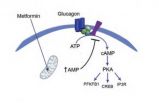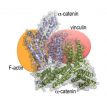The new method, developed by a group of researchers from the USA and Canada, could potentially cool trapped antihydrogen atoms to temperatures 25 times colder than already achieved, making them much more stable and a lot easier to experiment on.
The suggested method, which has been published today, 7 January 2013, in IOP Publishing's Journal of Physics B: Atomic, Molecular and Optical Physics, involves a laser which is directed at antihydrogen atoms to give them a 'kick', causing them to lose energy and cool down.
Antihydrogen atoms are formed in an ultra-high vacuum trap by injecting antiprotons into positron plasma. An atomic process causes the antiproton to capture a positron which gives an electronically excited antihydrogen atom.
Typically, the antihydrogen atoms have a lot of energy compared to the trapping depth which can distort the measurements of their properties. As it is only possible to trap very few antihydrogen atoms, the main method for reducing the high energies is to laser cool the atoms to extremely low temperatures.
Co-author of the study, Professor Francis Robicheaux of Auburn University in the USA, said: "By reducing the antihydrogen energy, it should be possible to perform more precise measurements of all of its parameters. Our proposed method could reduce the average energy of trapped antihydrogen by a factor of more than 10.
The ultimate goal of antihydrogen experiments is to compare its properties to those of hydrogen. Colder antihydrogen will be an important step for achieving this."
This process, known as Doppler cooling, is an established method for cooling atoms; however, because of the restricted parameters that are needed to trap antimatter, the researchers need to be absolutely sure that it is possible.
"It is not trivial to make the necessary amount of laser light at a specific wavelength of 121 nm. Even after making the light, it will be difficult to mesh it with an antihydrogen trapping experiment. By doing the calculations, we've shown that this effort is worthwhile," continued Professor Robicheaux.
Through a series of computer simulations, they showed that antihydrogen atoms could be cooled to around 20 millikelvin; trapped antihydrogen atoms so far have energies up to 500 millikelvin.
In 2011, researchers from CERN reported that they had trapped antimatter for over 1000 seconds – a record. A year later, the first experiments were performed on antihydrogen whilst it was trapped between a series of magnets.
Even though the processes that control the trapping are largely unknown, the researchers believe that the laser cooling should increase the amount of time antihydrogen can be trapped for.
"Whatever the processes are, having slower moving, and more deeply trapped, antihydrogen should decrease the loss rate," said Professor Robicheaux.
Colder antihydrogen atoms could also be used to measure the gravitational property of antimatter. "No one has ever seen antimatter actually fall in the field of gravity," said co-author Dr Makoto Fujiwara of TRIUMF, Canada's National Laboratory for Particle and Nuclear Physics. "Laser cooling would be a very significant step towards such an observation."
Antimatter fast facts:
Every particle has an antiparticle. For example, an electron's antiparticle is the positron and a proton's antiparticle is an antiproton. An antiparticle is exactly the same as its corresponding particle but carries an opposite charge. If a particle and its corresponding antiparticle meet, they destroy each other. This is known as annihilation. The combination of one positron and one antiproton creates antihydrogen. Theories suggest that after the Big Bang, equal amounts of matter and antimatter should have formed. As the Universe today is composed almost entirely of matter, it remains a great mystery why we don't have this symmetry. Scientists such as the ALPHA collaboration at CERN have been trying to measure the properties of antihydrogen to find clues as to why this asymmetry exists.
###
From Monday 7 January, the paper can be downloaded from iopscience.iop.org
Notes to Editors
Contact
1. For further information, a full draft of the journal paper or to contact one of the researchers, contact IOP Press Officer, Michael Bishop.
A proposal for laser cooling antihydrogen atoms
2. The published version of the paper "A proposal for laser cooling antihydrogen atoms" (2013 J. Phys. B: At. Mol. Opt. Phys. 46 025302) will be freely available online from Monday 7 January at iopscience.iop.org.
Journal of Physics B: Atomic, Molecular and Optical Physics
3. Journal of Physics B: Atomic, Molecular and Optical Physics covers the study of atoms, ions, molecules and clusters, and their structure and interactions with particles, photons or fields.
IOP Publishing
4. IOP Publishing provides publications through which leading-edge scientific research is distributed worldwide. IOP Publishing is central to the Institute of Physics (IOP), a not-for-profit society. Any financial surplus earned by IOP Publishing goes to support science through the activities of IOP. Beyond our traditional journals programme, we make high-value scientific information easily accessible through an ever-evolving portfolio of community websites, magazines, conference proceedings and a multitude of electronic services. Focused on making the most of new technologies, we're continually improving our electronic interfaces to make it easier for researchers to find exactly what they need, when they need it, in the format that suits them best. Go to http://ioppublishing.org/
The Institute of Physics
5. The Institute of Physics is a leading scientific society. We are a charitable organisation with a worldwide membership of more than 45,000, working together to advance physics education, research and application. We engage with policymakers and the general public to develop awareness and understanding of the value of physics and, through IOP Publishing, we are world leaders in professional scientific communications. END




